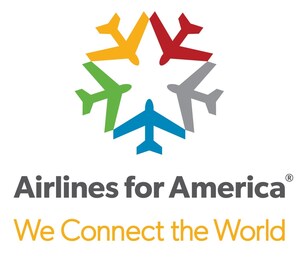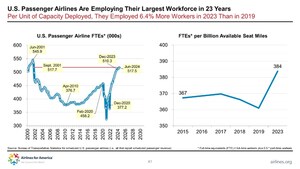WASHINGTON, Aug. 29, 2012 /PRNewswire-USNewswire/ -- Airlines for America (A4A), the industry trade organization for the leading U.S. airlines, today announced that the largest U.S. airlines are continuing to deliver record operational performance and great customer value, despite economic challenges and rising costs that led to a $1 billion loss for the first half of 2012.
(Logo: http://photos.prnewswire.com/prnh/20111201/DC15444LOGO)
"From a consumer perspective, it's a great time to travel by air," said A4A President and CEO Nicholas E. Calio. "We are in the safest period in aviation history; our members are delivering record on-time performance, airfares have not kept pace with inflation and customers today have greater options to choose products and services they value."
Adjusted for inflation, recent government data shows that average round-trip domestic airfares fell 16 percent from 2000 through 2011. During the same period, the inflation rate increased more than 30 percent and the average tax burden per domestic round-trip journey rose 42 percent. "Air travel remains the most efficient and one of the least expensive ways to travel," Calio said.
U.S. airlines in June delivered an improved on-time performance for the ninth consecutive month and the best-ever June baggage-handling results. Airlines continue to post on-time arrival rates greater than 80 percent, thanks to systemic airline changes and mild weather. Also in June, 99.67 percent of all U.S. airline passengers had their bags properly delivered, an all-time record for any June since the government began keeping records in 1988.
Gradually improving airline finances are driving job growth and an increased contribution to the economy. The Department of Transportation recently reported 18 consecutive months of job growth at the U.S. airlines. U.S. passenger airlines also are increasing their investment in new equipment with analysts predicting that more than $5 billion will be spent in 2012 on new aircraft and engines.
"Airlines continue to aggressively manage against steep cost increases, including fuel prices, which are expected to hit a record high in 2012 and continue to outpace increasing revenues," said A4A Vice President and Chief Economist John Heimlich.
At today's A4A state of the industry press briefing, the Massachusetts Institute of Technology released, "Productivity Trends in the U.S. Passenger Airline Industry 1978-2010," which examines airline productivity improvements since deregulation and the benefits to air travelers.
"By making dramatic improvements in aircraft utilization, labor productivity and fuel efficiency, U.S. airlines have been able to reduce unit operating costs by more than 35 percent in real terms since deregulation in 1978, even when surging fuel prices are included," said Dr. Peter Belobaba, principal research scientist at the MIT International Center for Air Transportation. "When combined with innovations in schedule optimization and capacity planning, these cost reductions have allowed real airfares to remain about 50 percent lower than before deregulation."
First-Half 2012 Financial Results
- Net Loss: The $1.07 billion net loss (-1.5 percent net margin) includes the results of 10 U.S. passenger airlines. The -1.5 percent margin was substantially lower than the -0.4 percent lost by these carriers in the same 2011 period.
- Revenue and Expenses: Operating revenue grew 8.2 percent but expenses increased 9.4 percent. Fuel costs jumped 13.1 percent compared with 2011. Fuel remained the industry's largest cost at about 34 percent of total operating expenses.
ABOUT A4A
Annually, commercial aviation helps drive more than $1 trillion in U.S. economic activity and nearly 10 million U.S. jobs. A4A airline members and their affiliates transport more than 90 percent of all U.S. airline passenger and cargo traffic. For more information about the airline industry, visit www.airlines.org and follow us on Twitter @airlinesdotorg.
SOURCE Airlines for America
WANT YOUR COMPANY'S NEWS FEATURED ON PRNEWSWIRE.COM?
Newsrooms &
Influencers
Digital Media
Outlets
Journalists
Opted In






Share this article